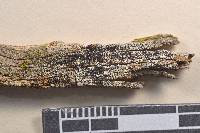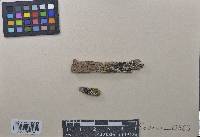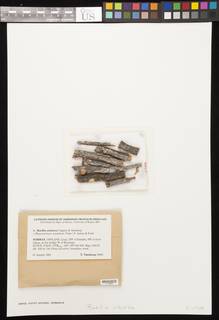
Consortium of Lichen Herbaria
- building a Global Consortium of Bryophytes and Lichens as keystones of cryptobiotic communities -
- Home
- Search
- Images
- Species Checklists
- US States: O-Z >
- US National Parks
- Central America
- South America
- US National Parks
- Southern Subpolar Region
|
|
|
|
Family: Caliciaceae
|
Nash, T.H., Ryan, B.D., Gries, C., Bungartz, F., (eds.) 2007. Lichen Flora of the Greater Sonoran Desert Region. Vol 3. Thallus: crustose, endosubstratic, thin and ±continuous, in parts becoming episubstratic and areolate; prothallus: white, thin, indistinctly delimiting the thallus surface: white, continuous, sorediate areoles: sparse, white, discrete or ±contiguous, becoming ±convex, usually esorediate soralia: developing within and bursting through the uppermost cell-layers of the substrate, thus often delimited by a thin, ±lacerate cell-layer derived from the substrate, pale green, bluish green, frequently darkened by a brownish or blackish tinge, orbicular in outline, or, in lignicolous specimens, ±flat to ±crateriform, <0.4 mm in diam., ellipsoid to elongate, i.e., following the fibers along the wood grain soredia: fine, powdery, <30 µm in diam., simple or loosely aggregated, strongly inspersed with crystals that dissolve in K, revealing an HNO3-, olive pigment within the outermost hyphae of exposed soredia medulla: not distinctly developed Apothecia: lecideine; (0.2-)0.3-0.4(0.5) mm in diam., initially ±immersed, bursting from the substrate and thus becoming sessile margin: black, thin, usually persistent, rarely excluded disc: black, epruinose, concave, rarely becoming plane proper exciple: dispersa-type, inner excipular hyphae distinct, not reduced, pigmented, prosoplectenchymatous (textura oblita), extending from the deep reddish brown hypothecium (leptoclinoidesbrown, textura intricata), outer excipular hyphae short-celled, cells angular, distinctly swollen (textura angularis) and ±carbonized with various amounts of a brown pigment (cf. elachista-brown, HNO3-) epihymenium: brown, pigmentation continuous with the outer exciple (HNO3-) hymenium: hyaline, strongly inspersed with oil droplets; paraphyses: simple to moderately branched, apically swollen, with a brown pigment cap (cf. elachista-brown) asci: clavate, Bacidia-type, 8-spored ascospores: soon brown, one-septate, narrowly ellipsoid, usually not constricted, with pointed ends, sometimes slightly curved, (17.5-)1925(-28) x (7.5-)8.5-10(-12.5) µm (measurements from Tønsberg 1992), occasionally with two additional false septa; proper septum: narrow, not thickening, but young spores often with a ±thickened endospore during spore ontogeny, lateral wall ±thickened (Callispora-type) Pycnidia: not seen Spot tests: K+ yellow, P± yellow, C- fluorescence: UV-(pale) iodine reactions: medulla and soredia non-amyloid Secondary metabolites: atranorin, placodiolic acid. Substrate and ecology: on bark or wood, mostly on a variety of coniferous trees World distribution: throughout temperate climates of the Northern Hemisphere, only recently reported from North America (Montana, USA) Sonoran distribution: recently discovered in southern California, frequently overlooked. Notes: Buellia arborea is one of two sorediate species found in the Sonoran desert region. If fertile, it is easily distinguished from B. griseovirens by its 1-septate instead of submuriform spores. Both species are, however, more commonly found without apothecia. Morphologically they can be very similar. Soredia of B. arborea are frequently, but not always surrounded by a thin lacerate margin, a papery cell layer derived from the substrate, when the soredia burst through. Soredia of B. arborea often become brownish or blackish and generally lack a yellow tinge frequently observed in B. griseovirens. Also, B. arborea is usually less distinctly areolate than B. griseovirens. If sterile, both species are most reliably distinguished by their secondary metabolites: Buellia arborea contains placodiolic acid, B. griseovirens norstictic acid. Both species typically, but not always also contain atranorin. Spot tests are not always reliable, because some specimens of B. griseovirens contain very little norstictic acid, reacting K+ yellow rather than red. The reactions should then be studied in the microscope, where norstictic acid forms needle-shaped orange crystals with K. Because of their oil inspersed hymenia and their similar spore types, Tønsberg (1992) suggested that B. arborea may by closely related to B. disciformis. |
Powered by Symbiota

















